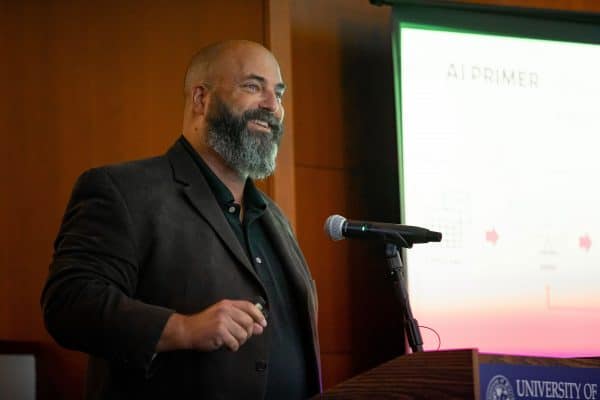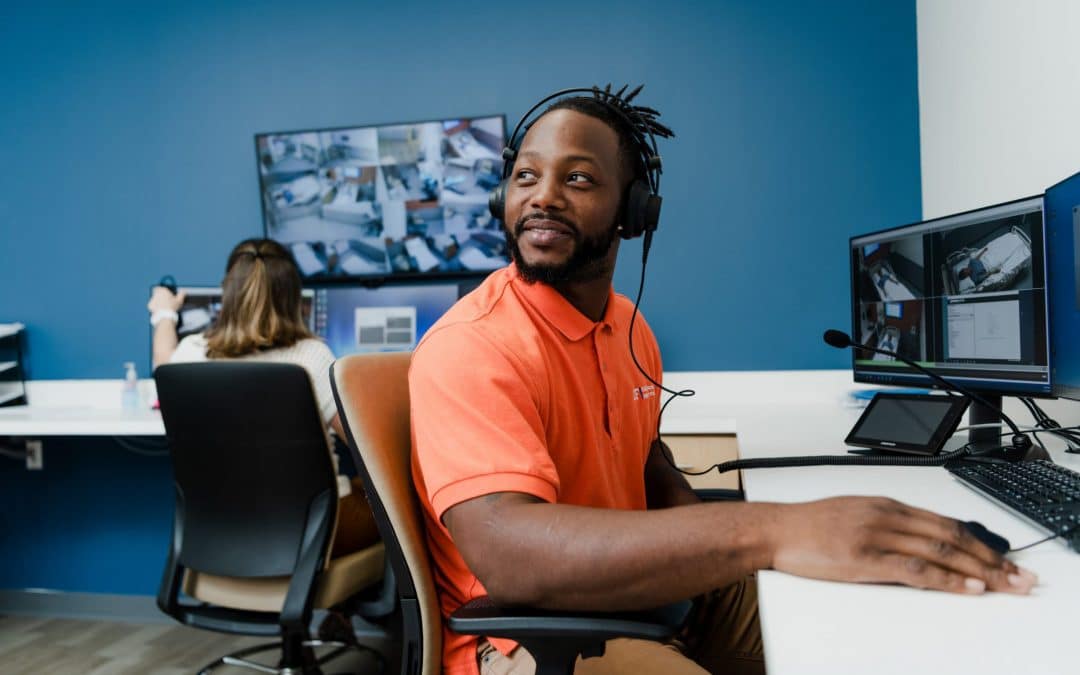How employees can thrive amid changes brought on by AI
Businesses have been incorporating AI technologies into their practices for several years, but how will these changing technologies impact our workforce? Clinical Professor and Executive Director of the Miller Retail Center Joel Davis explains what changes our workforce might expect to see and how employees can advance alongside the new technologies businesses are using.
Q: First and foremost, what is AI and what is an example of how people might interact with it daily?
Davis: Artificial intelligence is the simulation (sometimes imitation) of intelligent human behavior by a machine (computers). I think we all see parts of it every day, even if we don’t overtly label it.
For example, my car has a cool self-park feature. It finds an open spot and then drives into it. That requires a somewhat complex set of rules of behaviors, an algorithm that is trained on successful/unsuccessful parking examples and a ton of data. But to me, it is just a magic steering wheel that seems to take over.
The daily part of the question is interesting because I almost never use the self-park function on my car. This is an example of technology that is absolutely present, usable, and maybe not useful to me just yet.
Other examples often cited: Recommendations in your shopping carts online. This is one we see a lot of. It is not very glamorous, but the machine takes in your past habits, those of others likes you, and makes a recommendation on something to buy. It constantly tries to improve the recommendations you receive based on the training you provide the machine (buy that item/don’t but that item).
This technology can be insanely useful. I don’t want to page through five more screens to get a keyboard that pairs perfectly with that gaming mouse. Recommendations also come with some risks. When our recommendations become narrow and focused, we can end up in a bubble. Almost all my Amazon recommendations are for computers and technology, but what I need is to get more exercise. It should really recommend a tennis racket.

Clinical Professor and Executive Director of the Miller Retail Center Joel Davis.
Q: In what ways is the use of AI changing business?
Davis: This is not a new thing. Automation has been happening for a very long time. The change now is the places that automation is reaching. It is not only the factory jobs. It is every job.
Q: How do businesses benefit from incorporating AI into their practices?
Davis: If the work can be done cheaper, better, faster by a machine, then a business will see the benefit in adopting that machine and eventually using it. The business goal is usually decreased labor and increased production. On a smaller scale, almost any job that uses decision making based on some sort of data or record will benefit from improving the machine that helps make those decisions.
Q: There are some negative perceptions around AI in business, specifically when it comes to AI being used to reduce or eliminate jobs. Is that true?
Davis: I think a lot of people are pretty concerned about this. There is a lot of concern that AI will replace all workers, and usher in a jobless future. I think some of that is a little overblown.
On one side, optimists like to talk about the jobs that are created when new technology is introduced – companies’ productivity increases, consumers costs are lowered and everyone wins. But there are a lot of counter examples the pessimists can toss at this argument: A self-checkout cost at the big box store reduces labor costs, but does it does it improve productivity? Most of the time doesn’t it just shift the costs (time) to the consumer? If the burden is just moving from the big box store (labor costs) to the consumer, is this technology really improving anything?
I think both sides would agree that AI, or maybe more specifically automation will replace some, maybe even many workers. The two sides differ on the opportunity or risk that presents.
The first on the block are the those that do repetitive work. This is similar to factory automation. If a machine can do it faster, cheaper, better, then that human job will be replaced by a machine.
Throughout the 80s and 90s, this kind of job replacement erased a large number of low- and middle-income opportunities. In the near future, low- and middle-income job earners will still bear the brunt of the burden, which is an inequity that needs addressing, especially in service and manufacturing.
But the next wave will reach into the upper income levels as well, like jobs that require cognitive effort. Many of these jobs require college degrees, and they are in serious trouble. I think of these as being transactional jobs, input-action-output. Marketing analysts, advisors, midlevel supervisors— these are jobs AI will do better, cheaper, faster. If your job is “I look at the data and then I do….” you are at risk.
In general, though, I lean AI optimist. Yes, jobs will get replaced. We are in for a massive dislocation and disruption in the work force. It is just not reasonable to assume the cashier that was helping me at the store can shift to computer science and programming in the next two weeks. We are going to need large scale public-private partnerships to teach the skills that make workers valuable in the workplace. I am optimist because at the end of this, I think we can have something better.
In terms of jobs that could be reduced, the real problem then is not the lack of jobs or good jobs, it is that this massive shift in what jobs people will do and should do will fundamentally change work and society. How quickly can we retrain and retool for this future?
Maybe more importantly, we can’t really hold back this tide. It’s coming in.
In 1589, Queen Elizabeth I denied a patent for the stocking frame knitting machine and comments to William Lee, the inventor, “Thou aimest high, Master Lee. Consider thou what the invention could do to my poor subjects. It would assuredly bring to them ruin by depriving them of employment, thus making them beggars.”1 This didn’t stop factories from adopting that technology and displacing the workers.
How can AI be used to enhance employee efforts? For employees who could benefit from using AI systems in their work, but don’t have previous experience in doing so, how can they learn about using AI?
Davis: I think the key is this, almost all of us have many aspects of our work that will likely come under pressure from machines – 5%, 10%, 50%, 100%.
Individuals should be thinking about this, “How much of what I do is really better done by something else? What parts of my job are not at all automatable?” Even if AI can’t do all of my job, if it can do 25% of it, what does that mean for wages in my chosen career? How can I focus on making sure I am paid for the parts of my job AI can’t do?
More than that, be the agent of change. Accept and adopt technologies when they make sense and reasonably replace the effort you used to put it. Re-direct your effort to the parts of your job that AI doesn’t and can’t automate.




